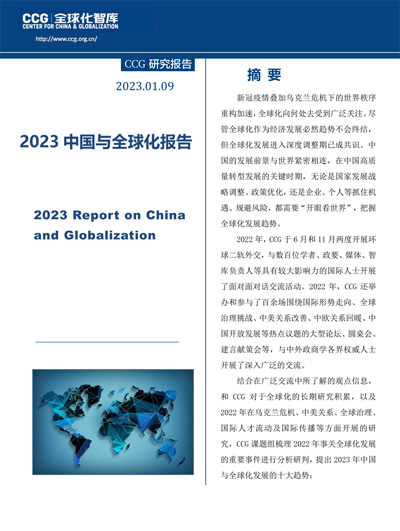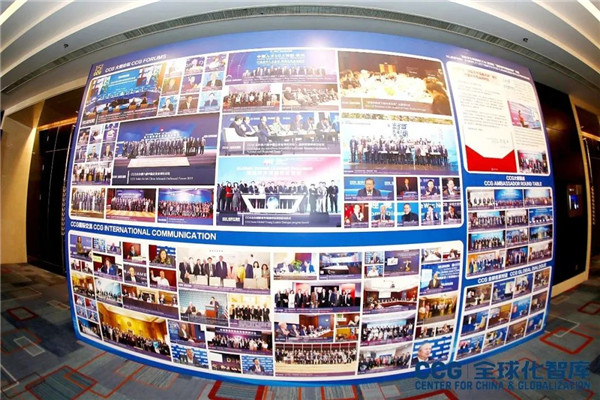CCG releases 2023 Report on China and Globalization
January 10 , 2023On Jan 9, CCG released 2023 Report on China and Globalization, which collects and analyzes potential trends in globalization for the coming year.
The Report, released at a time when there are major global changes underway, also looks at various milestones in globalization during 2022, which cover a range of ten themes, including China-US relations, the Ukraine Crisis, the global monetary system, the Belt and Road Initiative, international tourism, digital economy and climate change.
1.Bilateral relations between China and the United States may enter a stabilization phase, as both nations tread cautiously to avoid further deterioration of ties.
The U.S.-China relationship could gain some clarity after years of adjustments. In 2023, both nations will likely proceed cautiously with their interactions and communications, and bilateral trade relations are expected to remain relatively stable despite fluctuations. Politically, the two nations will remain distant and difficult, but will make cooperative efforts in some areas of global governance to ensure the stability and survival of the current system. Exchanges among business, academic, and corporate communities are expected to resume, though their progress will depend on policies and public opinion. Hopefully, the U.S. and China will restore their consulates in Houston and Chengdu in 2023.
Pragmatic and well-received international economic cooperation initiatives can curb anti-globalization and elevate China’s reputation as a leader in economic globalization. This increases the demand for international cooperation, strengthens global economic relationships, and brings new hope to the international community.
China can demonstrate its leadership of globalization through cooperation, not protectionism or unilateralism. China is advised to respond to protectionism with openness, not protectionism, and respond to unilateralism with multilateralism, not unilateralism. This strategy holds the potential for long-term success.
2.The ongoing conflict in Ukraine may enter a state of “frozen conflict,” characterized by a coexistence of negotiations and battles. While the war’s repercussions will be felt globally, they are unlikely to reverse the trend of economic globalization.
After a winter stalemate from late 2022 to early 2023, the West, Russia, and Ukraine would signal their consideration for negotiations to resolve the war as sustaining additional resources in the conflict proved difficult for the parties. Decisive and proper international intervention and statesmanship could lead to a freeze and, thus, fewer losses of life.
3.As central banks begin to halt interest rate hikes, inflation caused by volatility in supply chains and commodity prices may force global central banks to maintain current high interest rates.
In 2022, the decline of currencies against the US dollar caused capital flight and decreased foreign exchange reserves and debt crises in some developing nations. Some had to seek IMF bailouts. Despite the expected slowdown in Fed interest rate hikes in 2023, the strong dollar will persist to a certain extent, posing debt risks for developing countries with high external debt and attracting international capital.
Once believed to fill the void caused by a possible weakening of trust in and popularity of the US dollar, non-fiat digital currencies, commodities, gold, and stable yield bonds were considered alternatives. However, the strong dollar in late 2022 caused the decline of non-fiat digital currencies, commodities, and gold. The greenback’s dominance remains unchallenged, and no alternative has arisen.
Rising demand for RMB settlement in international transactions will necessitate higher RMB liquidity and may lead to greater currency volatility, presenting new challenges for China’s central bank’s monetary policy. Balancing orderly capital flows, stable exchange rates, and monetary policy is a challenge for the RMB in 2023 and beyond.
4.As China places increasing emphasis on consumption to revive its economy, the global economy may experience stagflation.
Amidst the pullback of various industrial sectors from China as a result of trade disputes and fluctuating economic factors, China remains steadfast as the premier manufacturing power globally, propelled by its formidable market size and sophisticated industrial support infrastructure. The emergence of new energy vehicles has spurred a reconfiguration of the worldwide automotive production chain, solidifying China’s position as a pivotal contributor to this re-emerging industry paradigm.
The advent of the COVID-19 in 2020 has occasioned a profusion of accommodative monetary policies in leading Western economies, precipitating inflation. Coupled with supply chain disruptions and energy price escalation from the Ukraine crisis, this has necessitated a shift towards a more assertive stance on interest rate policy by the Federal Reserve and the European Central Bank. This dynamic has resulted in a currency depreciation for numerous smaller economies, engendering elevated debt risk and exposing a considerable number of small- and medium-sized enterprises to the prospect of insolvency.
5.The Belt and Road Initiative enters its 10th year with China renewing its commitment to multilateralism, wide consultation, joint contribution, shared benefits, and international cooperation.
The United States has proposed the “Build Back Better World” (B3W) initiative, and the European Union has proposed the “Global Gateway” initiative in the same year. The parallel launch of these initiatives is not coincidental, as developed countries have proposed a number of similar connectivity projects following China’s 2013 BRI. They are responses to the changing trend of globalization and also a reaction to BRI.
In 2023, both the B3W and Global Gateway will focus on providing infrastructure development and investment financing for developing countries, addressing the challenges of climate change, and promoting livelihood and education development in these countries.
While the B3W and Global Gateway have strong ideological content, China can take the initiative and moral high ground by calling for cooperation with the BRI, which will have positive value and significance for developing countries.
It is important to note that the B3W and Global Gateway place a greater emphasis on the digital economy, new energy, environmental protection, and cooperation between governments and the private sector. In contrast, BRI focuses on promoting trade, investment, finance, and circulation, emphasizing overall economic cooperation and development. These differences mean that Western initiatives such as the B3W and GG will not compete with the Belt and Road at all levels, and the scope and level of their respective efforts will differ.
6.Following the Kuomintang (KMT) Party’s victory in the local elections in Taiwan, there may be positive developments in economic and cultural exchange across the Taiwan Strait. China’s strategic patience and practical strategies should not be underestimated, although high-level visits to Taiwan by certain senior U.S. politicians remain a most visible concern.
Cross-strait tensions are not reflective of the desires of the Taiwanese population, who overwhelmingly prioritize peace, stability, and good quality of life. The mainstream sentiment among the public is one of support for peaceful relations with the Chinese mainland.
In 2023, another visit by senior U.S. politicians, particularly the newly elected legislative leader, to Taiwan will exacerbate tensions in the Taiwan Strait and pose a paramount peril to the stability and tranquility of the Asia-Pacific region.
Fostering peaceful cross-strait relations through increased exchanges and cooperation, strengthening emotional and economic ties, and promoting a shared cultural and national identity, is not only beneficial for the prosperity of those on both sides of the Taiwan Strait, but should also be the prevailing trend.
7.The mixed market of private, state-owned, and foreign businesses, as well as joint ventures between them, will prove to be the backbone of China’s economy, the world’s second-largest. Beijing will continue to express confidence and interest in private and foreign investment.
China’s economy encompasses public and non-public sectors, which are integral to the country’s economic transformation, upgrading, and high-quality growth. General Secretary Xi Jinping has emphasized that a focus on fortifying the public sector economy and promoting the growth of the non-public sector economy should not be seen as mutually exclusive but as a harmonious and complementary relationship. The public and non-public sectors should augment one another rather than compete or cancel each other out.
8.With the lifting of Covid-19 restrictions, China will see a significant rebound in cross-border travel, particularly in commerce, tourism, and studying abroad. Similarly, international travel, work, and study in China will pick up.
The past three years have seen a drastic decline in traditional forms of human exchange including international travel and study due to COVID-19 restrictions. Despite its popularity, online communication cannot fully substitute traditional forms of human interaction. In 2023, a strong recovery is predicted for both international travel and study, as China pivots from its COVID-19 measures.
9.Global governance of the digital economy will shift from fragmentation to modularity, as new regulatory and cooperation systems are established from the bottom up. China will actively participate in the development and governance of the global digital economy.
It is suggested that China concentrate on two key areas of global digital economy governance.
Firstly, it is advised that China utilize various cooperation platforms, from WTO to DEPA, to enhance digital economy in trade facilitation, better the digital business environment, and unleash the potential of the digital economy. The creation of China’s working group to join DEPA in August 2022 has been a significant step towards aligning with DEPA’s digital governance rules.
Secondly, it is advised that China advocate for its Global Initiative on Data Security, which was introduced in 2020, and establish data security cooperation initiatives with regional international organizations and mechanisms. For instance, China has signed data security cooperation agreements with the Arab League and ASEAN. Such initiatives are likely to continue expanding in the international community.
10.Climate change will continue to be a prominent international concern, but a global joint effort is uncertain. The United Nations will continue to play a crucial role, but more concrete results may come from partnerships between individual countries, blocs, and regional cooperation mechanisms.
The progress in addressing climate change has been slow and challenging. The main obstacles are funding, accountability, and prioritizing the agenda, which are highly debated topics. The “loss and damage” fund was established at COP27, but the debate over funding continues. There are disagreements over how developed countries will fulfill their financial obligations, the EU’s carbon tax, and the classification of China as a “developing country.” These differing interests make it difficult for all parties to reach a consensus.







